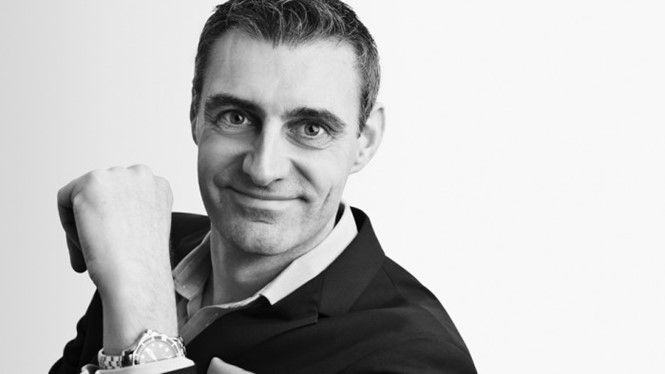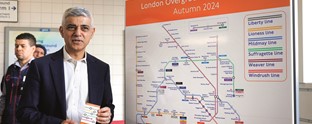Two’s company: Jim Prior on running brand agencies

It’s been nearly a year since Jim Prior added the stewardship of Lambie Nairn to his existing role as CEO of the Partners. He and Andrew Thomas discuss the challenges of running not just one but two global brand agencies
Ask Jim Prior, CEO of both Lambie Nairn and the Partners to list his proudest achievements, and high on that list is an app called TimeSaver, developed by the Partners for Deloitte. The Partners had a seven-year relationship with the global accountancy firm, during which time it underwent a much-praised rebrand. Every Monday, Prior would wake and see dozens of emails from Deloitte staff who had spent their Sunday afternoons and evenings catching up on correspondence. “Someone told me their week was so busy with back-to-back meetings, literally from Monday at 8am until Friday at 6pm, that the only time for emails was Sundays,” Prior says. “Most people worked on the premise a meeting tracked time as a progression around 360 degrees. So we took a digital clock and made it circle around 360 degrees in 45 minutes, rather than an hour. Everyone’s in on the trick. No one’s trying to pretend that it’s 60 minutes, but just psychologically you get yourself to think a little bit differently.”
If anyone knows anything about having to steal time it’s Prior. As CEO of brand agency the Partners since 2001, he took on the same role for WPP stable-mate Lambie Nairn last April. The additional demands on his hours haven’t phased him, however. “There are people running agencies that are probably bigger than the combination of these two. I think for me it’s less an issue of time and more an issue of quality. I think to run an agency, you have to be clear about the kind of leadership an agency needs and then deliver that appropriately in each case. Whatever the hours you utilise, you have to utilise them in the right way. It is a lot more manageable than people think,” he says.
The Partners was founded in 1983, but has tripled in size since Prior took the reins. When Lambie Nairn needed experience at its helm, Prior’s success at the Partners combined with the experience he’d picked up along the way, made him a natural fit to run both agencies. “I was at a point in my career where that kind of move was something I was ready for,” says Prior. “It’s not a question of being physically present in a building and clocking in and clocking out for 60, 70 hours a week. It’s about making the right interventions and it was possible and extremely doable to achieve that with a role that extends to another company as well. It’s been about having the right focus in the business.”
Prior sees the two businesses as positioned differently. Although they complement each other both geographically and by skill set, he’s adamant that his role is not a precursor to a cost-saving merger. “Categorically, we will not merge the two businesses. It’s not in our interest or in the interest of our clients,” Prior says. “I want to be at the forefront of the progressive edge of how we solve problems for our clients, and that requires [both agencies] to think intuitively, but differently. I think there are certain circumstances where I would say clearly one of these agencies better plays to solve this versus the other. There are other situations in which I would say you know what, both these agencies can solve that problem.”
That doesn’t occur often, but it still happens. “When I took this job over, the first question I was asked was what are you going to do if the two businesses are competing against each other in a pitch? I said to the person asking me the question, ‘We will see how we manage it at the time but it won’t happen very often.’ Within two weeks we were competing against each other! I sat back, and the teams who were leading pitch developed their own approach. I had a certain degree of awareness of what was being pitched. It’s not my intention to interfere or try to manipulate the direction of either of the pitches. One of the companies was successful and the other one, according to the client, was in second place. I think that’s a good process. I think its good for WPP and I think it’s good for the client,” Prior says.
Prior says the businesses that have performed strongly during the economic downturn are the ones with the clearest propositions, “I can look at the Partners through a time period from 2005 to 2014 where the business has grown nine out of 10 years…and I would say that much of that is because the business had a very strong sense of itself and delivered that proposition into the market very clearly. I think we’ve been doing the same now with Lambie Nairn. We’ve really sharpened the proposition.”
“To run an agency, you have to be clear about the kind of leadership an agency needs and then deliver that appropriately in each case. Whatever the hours you utilise, you have to utilise them in the right way. It is a lot more manageable than people think.”
Prior thinks he’s sharpened and simplified the offering of his own agencies but he says the marketing and brand landscape is becoming more complex. “Everybody can do what everybody else does these days. The brand consultancies claim they can produce advertising and digital solutions, ad agencies claim they can do strategy and design as do digital companies. I think broadly speaking brand consultants are still way better at taking the higher-level brand view. The advertising agencies are still more outcome driven, and I think digital skill is very much driven by technology and the possibility of technology. But a smart person is a smart person. There is much more literacy generally these days around brands and of course people can shift quite fluently from ad agency environment to digital environment to brand environment. So the skills have become transferable. What we as a brand industry need to do is to get better and sharper at articulating where our real value is. I think that is the real opportunity,” he says.
It’s not just the agencies that Prior says have changed, but clients as well. “Clients have got much more used to bringing more people around the table at the initial discussion phase,” he says. “They are much more open-minded to the fact that solution could come from anywhere and are happy at breaking up assignments into small chunks so someone can focus on the strategy and someone else on an identity solution or some kind of naming solution. So it’s getting harder and harder to compete.”
Before joining the Partners, Prior had decent stints at Levi’s as head of marketing, and Converse where he ran product marketing for the EMEA region. He says this gave him invaluable experience, but that he made the switch at the best possible time, “I was very lucky. I switched from client-side to agency-side at just the right point in my career. The problem I had was at that stage very few agencies were prepared to take on someone relatively senior with absolutely no experience of working in an agency. The Partners had different ways of thinking.”
He is keen to recommend his career path, “I think the industry needs more people who have seen the client side of things, who understand the context in which organisations have to operate. I would advise people if you can get that experience, get it.”
There are other challenges that Prior feels the branding industry needs to confront. “As an industry we have to modernise ourselves and we have to really drive our relevancy home. This industry used to make its money by designing brand identities and delivering brand identities at a static point in time with things like 400 pages of guidelines and roll-out programs that would go around the world for 24 months and so on. All that stuff is under challenge in the new model. The way brands are created, designed and managed is much more fluid and adaptive. Agencies have to adapt and respond within that. We have to move our model to be a much more continuous value add, much more on how you continue to manage brands and all of its aspects through to how it gets delivered and the kind of visual expressions of it.” The people who make up the agency hiring pool will have to change to meet these shifts too. “I think there’s going to be more of a demand for really smart, fast thinkers and less demand for people who are very strong process managers which could have accounted for 33% of many agencies workforce to a certain point. That’s the way we’re going and it’s a big challenge” he adds.
Challenges of credibility aside, Prior is confident about the future. “I’m convinced this is an industry that is going to be seen as more and more significantly important, not just by CMOs but by CEOs and shareholders in time. As an industry we have to continue to establish ourselves as a credible and extremely important driver of business success.”


